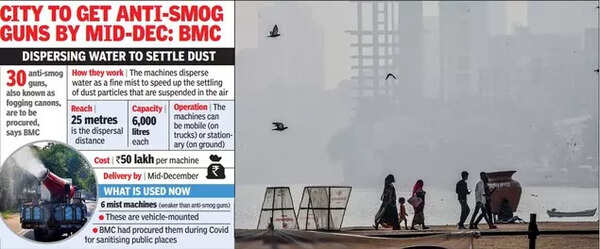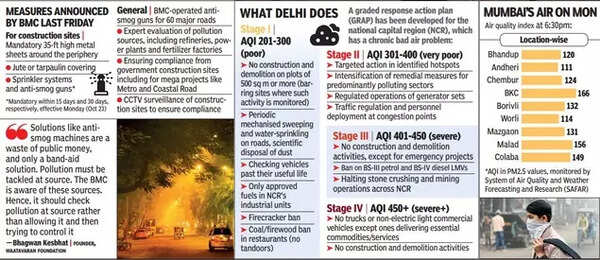[ad_1]
Those measuring air quality have seen a “phenomenal jump” in particulate matter and other pollutants over Mumbai between October 2022 and 2023. In fact, the average concentration of particulate matter over the city of Mumbai has increased by 100%.

Terming the situation as “grave” and requiring “drastic measures”, a senior scientist linked to the National Clean Air Programme, Sachchida Nand Tripathi, called for action that is real-time and punitive for offenders who do not follow set guidelines.
Track the pollution level in your city
The city civic body’s much-touted anti-smog guns are merely for “fire-fighting” and do not solve the problem of gaseous emissions and fine particles in the air, said another expert. Rakesh Kumar, former head of National Environment Engineering and Research Institute, said the guns which spray mist would not be effective as they are meant to dispel bigger particles. “The current problem is that of gaseous emissions, the haze that is created due to ozone levels and of fine particles,” Kumar said.

Monitor pollution real-time: Experts
Real-time monitoring of polluting sites and simultaneous assessment of measures taken to combat air pollution are the way forward for Mumbai, said experts speaking about the deteriorating ambient conditions.
“The current problem is that of gaseous emissions, the haze that is created due to ozone levels and of fine particles. The smog guns as seen in Delhi have very little impact. At the least, one could say, this is a small effort in fire-fighting. It is not solving your problem,” said Rakesh Kumar, former head of National Environment Engineering and Research Institute (NEERI), while speaking about the recent steps taken by the BMC.
“Across the city, one needs to monitor construction sites and other industry emissions and traffic. There ought to be clear guidelines in place on how construction sites are protected by creating sheds and ensuring that dust does not escape these sites by densely monitoring them,” said Sachchida Nand Tripathi, co-ordinator of the National Knowledge Network, formed under the National Clean Air Program (NCAP) run by the ministry of environment, forest and climate change.
The NCAP has set targets for all Indian cities to achieve 20-30% reduction in particulate matter by 2024. Since the program began in 2017, Mumbai’s air quality has worsened. Tripathi said while construction sites are huge contributors to generating dust, one cannot ignore industrial emission and traffic to some extent, all of which add to particulate matter loading.
The Prime Minister’s Office has called on chief minister Eknath Shinde to intervene and take steps to check Mumbai’s pollution. The BMC thereafter came up with dust mitigation plans for construction sites, deployment of anti-smog guns on 60 major roads and expert evaluation of pollution sources like refineries, power plants and fertiliser units. The city currently has about 6,000 ongoing construction projects-both private and public. Kumar added that demolition is also adding hugely to particulate matter in the air; wet demolition which means spraying water on the concrete block and then hammering it would ensure that dust particles do not fly, he said. Additionally, he said trucks from construction sites were leaving tyre marks and those once dry were adding to the dust in the air.
Defining some solutions, Tripathi said the city needed “dense and effective monitoring and real-time analytics” that would feed into the dashboard of the regulator so that alerts can be issued in real time and action taken immediately. “Imagine a construction site and if one can see there is a big spike by looking at PM2.5 and PM10 (particles with diameter of 2.5-10 micrometre) and this information comes to the BMC in real time and to the pollution control board, they can immediately call them and inform them that the site is not complying with the norm. Either follow the norms or shut down construction,” professor Tripathi of the IIT Kanpur explained.
[ad_2]
Source link




